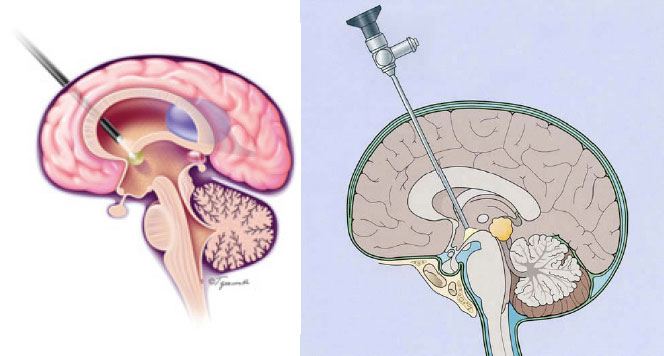Endoscopic surgerty:
The endoscopic procedure is a minimally invasive procedure which gives access to the deepest part of the brain using an instrument called an endoscope.
The procedure can be performed to:
- Inspect the brain
- Biopsy/remove small tumours
- Drain/remove cysts and
- Create bypass channels for circulation of cerebrospinal fluid (CSF)
A small cut is made in the scalp over the site of the underlying problem. A small hole is drilled into the skull beneath the cut and the firm covering of the brain is opened.
The endoscope is passed through the small hole into the brain. Sometimes, it is necessary to create a small pathway through the brain with the endoscope to reach the problem. Using this technique, access to parts of the brain can be achieved with relative ease.
When completed the endoscope is removed.
Endoscopic third ventriculostomy is performed as an adjunct to the endoscopic procedure in order to create an opening into one of the fluid filled cavities of the brain called the third ventricle.
This procedure is performed to bypass any obstruction to the flow of cerebrospinal fluid. To achieve this the endoscope is passed into fluid filled cavities (ventricles) within the centre of the brain. The endoscope is navigated into the third ventricle and a small opening is made in the floor of the third ventricle.
This allows the excess cerebrospinal fluid to drain away from the brain, relieving any pressure.
The cut is closed with stitches or staples.
- Endoscopic procedure
- Endoscopic third
- Ventriculostomy
My Anaesthetic
This procedure will require a General Anaesthetic.
See About your Anaesthetic information sheet for information about the anaesthetic and the risks involved. If you have any concerns, talk these over with your doctor.
If you have not been given an information sheet, please ask for one.
What are the risks of this specific procedure?
There are some risks/complications with this procedure.
Common risks include:
- Infection. This may need antibiotics and further treatment.
- Minor pain, bruising and/or infection from IV cannula site. This may require treatment with antibiotics.
- Bleeding. A return to the operating room for further surgery may be required if bleeding occurs. Bleeding is more common if you have been taking blood thinning drugs such as Warfarin, Aspirin, Clopidogrel (Plavix or Iscover) or Dipyridamole (Persantin or Asasantin).
Uncommon risks include:
- A heart attack because of the strain on the heart.
- Stroke or stroke like complications can occur which can cause weakness in the face, arms and legs. This could be temporary or permanent.
- A definitive diagnosis may not be required if the procedure is done for biopsy. This may require further surgery.
- Epilepsy which may require medication. This condition may be temporary or permanent.
- Failure to adequately control the circulation of brain fluid. This may be evident straight after surgery or may present later after adequate control had been achieved. This may require further surgery.
- Small areas of the lung may collapse, increasing the risk of chest infection. This may need antibiotics and physiotherapy.
- Increase risk in obese people of wound infection, chest infection, heart and lung complications, and thrombosis.
- Clots in the leg (deep vein thrombosis or DVT) with pain and swelling. Rarely part of this clot may break off and go into the lungs.
Rare risks include:
- Meningitis. This may require further surgery.
- Injury to the brain, important nerves or blood vessels. This can lead to stroke like complications which can cause weakness in the face, arms and/or legs
- Fluid leakage from around the brain can occur after the operation. This may require further surgery.
- Death is rare due to this procedure.






